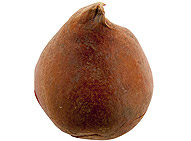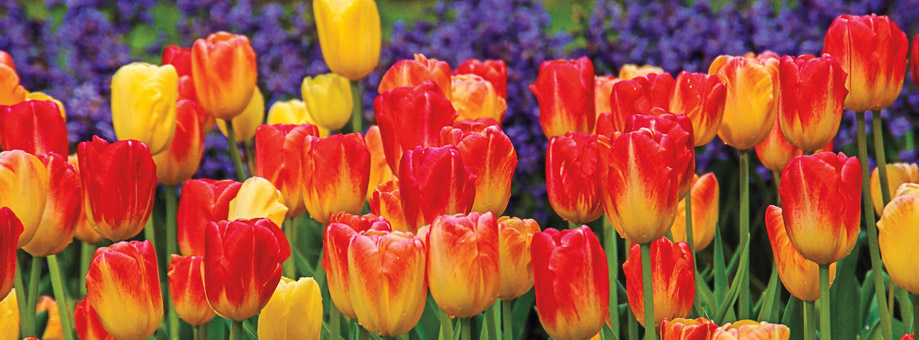- About Bulbs
- Landscaping Tips
- Planting & Care of Bulbs
- Tips for buying Bulbs & Perennials
- Planting & Growing Instructions
- Allium Planting and Growing Tips
- Astilbe Planting and Growing Tips
- Begonias Planting and Growing Tips
- Calla Lily Planting and Growing Tips
- Crocus Planting and Growing Tips
- Daffodil Planting and Growing Tips
- Dahlia Planting and Growing Tips
- Daylily Planting and Growing Tips
- Gladiolus Planting and Growing Tips
- Hosta Planting and Growing Tips
- Hyacinth Planting and Growing Tips
- Iris Planting and Growing Tips
- Lily Planting and Growing Tips
- Peony Planting and Growing Tips
- Rose Planting and Growing Tips
- Tulip Planting and Growing Tips

Discover the joy of cultivating vibrant tulips with our expert tips on tulip care and planting. People grow tulips for many reasons. They have gorgeous and colourful blooms. They are easy to grow and maintain. Tulips look lovely whether planted in large groups or scattered here and there in borders, along pathways and beside buildings. And, of course, they are beautiful as cut flowers in a vase or bouquet.
If you are wondering how to plant tulips, we recommend following the steps below for the best blooms every spring. Pre-order your tulip bulbs to get the best selection. Your bulbs will be shipped directly from our facilities in Holland and arrive at your front door at the perfect planting time. Learning how to care for tulips is easy and rewarding, as they thrive effortlessly and bring beauty to landscapes. Explore more with this tulip planting guide.Preparing the Soil
Before your bulbs arrive, you can improve poor soil by adding some organic matter in the
form of compost or aged manure and working it
thoroughly into the existing soil. After this has been done and a few days have passed
to allow the soil to settle, you are ready to plant
your bulbs.
Planting Tulip Bulbs
Tulips are very easy to grow. Most gardeners plant their bulbs in November in full sun. Place your tulips about 6" deep in moderately loamy soil with some humus and sand added. After flowering, allow bulb foliage to wither before cutting—that way, sap in the foliage returns to the bulb where it provides added strength for next year.
If you are wondering how to plant tulips, we recommend following the steps below for the best blooms every spring. Pre-order your tulip bulbs to get the best selection. Your bulbs will be shipped directly from our facilities in Holland and arrive at your front door at the perfect planting time. Learning how to care for tulips is easy and rewarding, as they thrive effortlessly and bring beauty to landscapes. Explore more with this tulip planting guide.
Choosing Tulips to Plant
There are several thousand varieties of tulip bulbs, so choosing the ones you want to grow might be the hardest part of the entire process. Tulips are available in many different colours, sizes and shapes. There are single tulips, double tulips, multicoloured tulips, parrot tulips, fringed tulips, Darwin hybrid tulips—the list goes on and on. If you haven't done it already, we suggest browsing the tulip selection on our site and see what appeals to you.How to Plant Tulips
The keys to successfully growing tulips is preparing the soil prior to planting and then properly planting the bulbs. It sounds simple—and it is!Preparing the Soil
Before your bulbs arrive, you can improve poor soil by adding some organic matter in the
form of compost or aged manure and working it
thoroughly into the existing soil. After this has been done and a few days have passed
to allow the soil to settle, you are ready to plant
your bulbs.
Planting Tulip Bulbs
- Place your tulip bulbs, tips facing upward, about 6 inches deep in well-drained, moderately loamy soil with some humus and sand added. This will help naturalizing or perennializing, and cut down on the risk of disease and fungus.
- Water after planting to ensure that your tulips develop a strong root system before going dormant during winter.
- After flowering, let bulb foliage wither before cutting. This allows sap in the foliage to return to the bulb, where it provides added strength for next year.
How to Care for Tulips
If you are worried about how to take care of tulips, just remember the basics about plant care and you should be fine. Don't give them too much water. Don't let the soil become too dry. Feed them a couple of times each year. Unless they are hardy perennial tulips, like Darwin hybrids, lift the bulbs after the foliage has ripened and store them in a dry place during summer until you replant them in fall.Watering Tulips
Water tulip bulbs thoroughly when planting in fall and again when they begin sprouting in spring. Do not overwater.Fertilizing Tulips
Tulips perform best when compost is applied annually to provide them with nutrients needed for healthy blooms. Tulips should also receive plant food in fall and spring.What to Do After Tulips Bloom
To encourage perennial tulips to return year after year, cut back the stem to the base of the plant after the flowers fade. Cut back foliage once it has turned brown. Most garden tulips are hybrids, so they are not perennials; their bulbs should be dug up and composted.Where to Plant Tulips
Tulips are well suited for planting along walkways, in front of building foundations, beside fences, in spring borders or in large groups to create a sea of blooms. Use good-quality planting mix, not garden soil, if planting in a container. Containers should be large to give roots plenty of room for growth and keep bulbs healthy. Avoid placing containers in direct sunlight, to prevent the soil from warming up and tricking bulbs from sending up shoots too soon.When to Plant Tulip Bulbs
Tulips are planted in fall, before the ground is frozen. They need a cool season in the earth to begin growing their roots and preparing for dormancy. Depending on the zone in which you live, they are typically planted in September, October or November.How to Cut Tulip Flowers
Tulips should be cut while the buds are still tight. Trim off at least half an inch of each stem, cutting at a 45-degree angle. Fill a clean vase with room-temperature water and place the tulip stems in the vase. You may notice the cut tulips elongating as they absorb water. If the stems become too long, snip a few inches off the bottom. Change the water every couple of days.Tulip Varieties
Few things in nature are as beautiful as a flowering tulip standing at attention beneath a clear, blue sky. What's more, the appearance of those first tulip sprouts of the season poking up through the soil brings with it the expectation of a spectacular springtime show in the landscape. There are many, many varieties of these beloved bulbs. Some of our favourites include Red Dynasty, Apricot Pride, Rainbow Parrot, Temple of Beauty, Blue Heron, Queensland and Nachtwacht. Some growers purchase our mixtures and collections as affordable options for adding large amounts of tulip beauty to their green spaces.Perennial Tulips Care
Perennial tulips are special because, unlike many hybrids, they come back reliably year after year. Besides choosing a truly perennial variety, there are a few steps you can take to ensure perennial performance. Plant bulbs in well-drained soil. This will help naturalizing or perennializing and cut down on the risk of disease and fungus. Plant bulbs deep. Measuring from the base of the bulb, place the tulip about 6" inches deep. Water after planting. This will ensure that your tulips develop a strong root system before going into winter dormancy. After the blossoms have peaked, remove the flower heads and allow the green foliage to die back. Fertilize in fall and spring.Tulips are very easy to grow. Most gardeners plant their bulbs in November in full sun. Place your tulips about 6" deep in moderately loamy soil with some humus and sand added. After flowering, allow bulb foliage to wither before cutting—that way, sap in the foliage returns to the bulb where it provides added strength for next year.
Darwin Hybrid Tulips Care
Darwin hybrids are tulips beloved for their large, egg-shaped blooms and tall, strong stems that can withstand the wind and the rain. They are cultivated extensively as cut flowers due to their size, sturdiness and wide range of bright colours. Darwin hybrids are among the best tulips blooming for up to five years each spring when care is taken to remove their faded blooms. For best results, plant them in fertile, well-drained soil where they will receive a good amount of morning sunshine but will not be subjected to too much direct afternoon sunlight during hot weather. Some of our favorites are Sun Gold, Halley's Comet and Guinevere Jumbo Perennial Tulips.Harvesting Tulips
The ideal time to cut tulips for bouquets is in the early morning, when the blooms are still cool and closed. Choose flowers that are just beginning to show colour but haven't fully opened. Using sharp, clean shears, cut the stems at an angle to allow for better water absorption. Place them immediately in water to prevent the stems from sealing up. If possible, cut the stems underwater, to help prevent the formation of air bubbles that can block water uptake. Remove any leaves that will be below the waterline to reduce bacterial growth. Finally, place them in a clean vase with fresh water and a floral preservative for extended freshness.Potting & Repotting Tulips
To pot tulip bulbs, choose a pot with drainage holes and fill it with soil that drains well, leaving enough space for the bulbs. Place the bulbs close together but not touching, with their pointed ends facing up. Cover them with soil, leaving the tips slightly exposed. Water thoroughly and place the pot in a cool, dark place until shoots appear. For repotting, gently remove the bulbs from the current pot after the foliage has died back. Inspect and discard any unhealthy bulbs. Then, repot them in fresh soil using the same method as before, ensuring the pot has adequate drainage to prevent bulb rot.Tulip Pests & Diseases
Tulips are susceptible to several pests and diseases. The most common pests include aphids, which suck sap and can spread viruses, and tulip thrips, tiny insects that damage petals and leaves. Among diseases, tulip fire (caused by the fungus Botrytis tulipae) leads to brown spots and twisted growth. Bulb rot, primarily due to wet conditions, results in soft, discoloured bulbs. Tulip breaking virus causes streaked or mottled petals, but while it's visually striking, it weakens the plant. Regular monitoring, proper watering and good hygiene practices, like removing affected plant parts, are key to preventing and managing these issues.Tulip FAQs
What Colors Are Tulips?
Tulips display a spectacular array of colours, ranging from vibrant primary shades to subtle pastels. You can find tulips in almost every colour, including red, yellow, pink, purple, orange and white. Remarkably, tulips also come in bicolour varieties, featuring petals that combine two distinct hues, often in striking patterns. Some tulips exhibit unique striped or streaked patterns, a result of natural genetic variations or the influence of certain viruses, which, while detrimental to the plant's health, create stunning visual effects. Additionally, there are tulips with fringed petals, where the edges appear delicately feathered or frayed, adding an extra dimension of texture and visual interest.How Long Do Tulips Last?
Tulip blooms typically last for a period of 5-10 days under optimal weather conditions. However, the longevity of their blooms can vary depending on the tulip variety, local climate and care that is given. Generally, cooler temperatures can prolong the bloom period. Tulips have a broad range of blooming times, categorized as early-, mid-, and late-season, spanning from early spring to late spring. Early-season tulips bloom as soon as the weather begins to warm, often in March or April, while mid-season varieties bloom in April, and late-season tulips flower toward the end of April and into May.What Do Tulips Represent or Symbolize?
Tulips carry rich symbolism and meanings, often related to their colour. Generally, they represent perfect love and are considered a symbol of spring and renewal due to their early blooming. Red tulips are strongly associated with true love, while purple tulips symbolize royalty and elegance. Yellow tulips, once representing hopeless love, now convey cheerful thoughts and sunshine. White tulips are used to claim worthiness or send a message of forgiveness. Variegated tulips, with their streaked petals, represent beautiful eyes. Historically, in the 17th century, tulips symbolized wealth and status during the Dutch Golden Age.You May Like...










